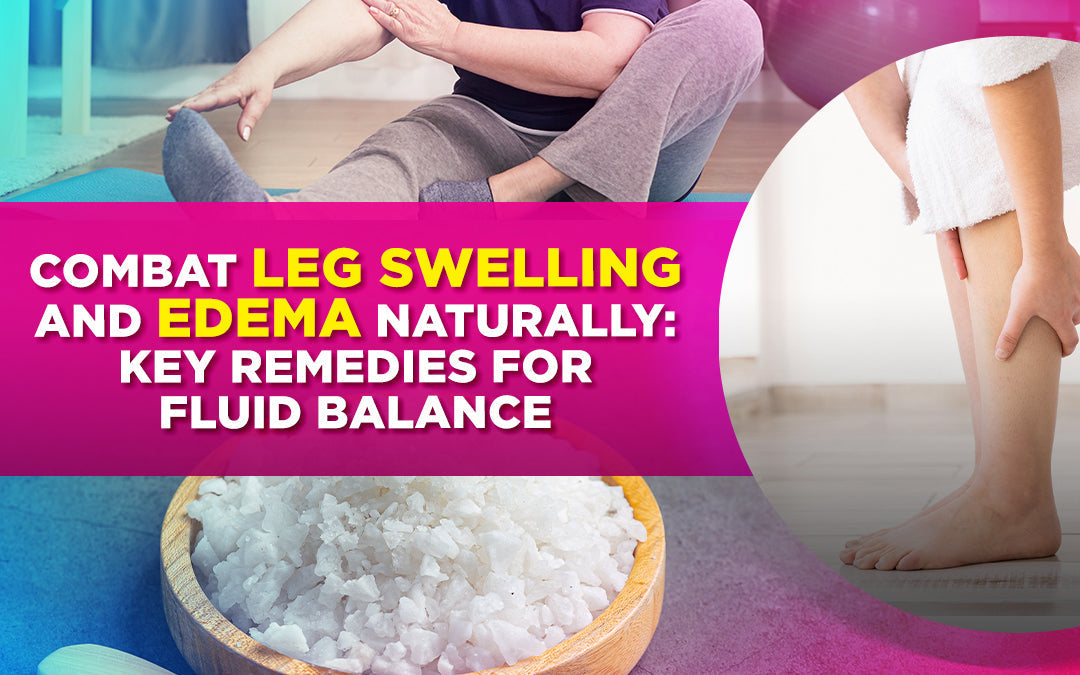Combat Leg Swelling and Edema Naturally: Key Remedies for Fluid Balance
Dr LivingoodShare

Are you dealing with persistent leg swelling or edema?
Understanding the delicate balance of fluids within your body is the first step to addressing this issue.
Here are some common questions about how to handle this health issue:
“How do you reverse edema swelling in your legs naturally?”
“How can I get rid of fluid in my legs fast?”
“What are some home remedies to support edema in legs and feet?”
“What are some remedies to support edema naturally?”
In this comprehensive guide, we’ll explore six key remedies, with a particular focus on the often-overlooked benefits of rebounding.

1. Fluid Balance and Movement: The Foundation of Healthy Legs
The human body relies on a delicate equilibrium of fluids to function optimally.
When this balance is disrupted, fluids can accumulate in the extremities, particularly the legs, due to the absence of automatic pumps for fluid return.
Unlike blood flow, which is driven by the heart’s powerful pump, fluid movement depends on physical activity and osmosis.
If the fluid doesn’t make its way back to the heart, it can lead to swelling and edema.
This is particularly common in individuals with limited mobility.
To counteract this, incorporating movement into your routine is crucial.
Daily activities, such as walking, contribute to activating the venous pumps that help drive fluid back up the legs and into the heart.
Movement is a fundamental remedy for maintaining fluid balance and preventing leg swelling.

2. Mineral Balance: Striking the Right Note
Achieving the right balance between salt and potassium is paramount for overall health and for preventing fluid retention.
The body’s fluid balance relies on maintaining an equilibrium between these two minerals.
Both an excess and a deficiency of salt can pose risks, affecting heart health and fluid levels.
While many tend to demonize salt, it’s essential to recognize that the key lies in moderation and choosing the right sources.
Processed salts found in many packaged foods can contribute to fluid imbalance.
On the other hand, incorporating healthy salts, such as Himalayan or Celtic Sea salts, provides necessary minerals and electrolytes without the drawbacks of processed alternatives.
Potassium plays a pivotal role in counteracting the effects of sodium, maintaining a harmonious balance in fluid movement within the body.
Unfortunately, many people fall short of the recommended potassium intake.
Boosting potassium levels through a diet rich in green foods, vegetables, and a daily greens powder can significantly contribute to maintaining a healthy fluid balance and alleviating leg swelling.

3. The Insulin Connection: Controlling Fluid Movement
Insulin, often associated with blood sugar regulation, plays an unexpected role in fluid movement within the body.
Similar to sodium and potassium, insulin influences how fluids are distributed.
Elevated insulin levels are linked to increased fluid retention, which can exacerbate leg swelling and edema.
Adopting an insulin-friendly lifestyle involves minimizing sugar intake and avoiding foods that cause insulin spikes.
This transition may be likened to overcoming an addiction, requiring a period of complete elimination to reset the body’s responsiveness.
By reducing insulin levels, individuals may experience improved fluid balance and reduced swelling, especially in the legs.
4. Increase Electrolytes: Nourishing Your Body
In addition to incorporating potassium-rich foods into your diet, ensuring an adequate intake of other electrolytes is vital, especially if you’re making lifestyle changes that affect insulin levels.
Electrolytes, including potassium and magnesium, play a crucial role in maintaining fluid balance and preventing dehydration.
While sports drinks are a common source of electrolytes, they often come with unwanted sugars.
Instead, opt for natural alternatives such as an electrolyte powder that provides the necessary minerals without the drawbacks of added sugars.
Prioritizing potassium-rich foods and electrolyte supplementation can further enhance your body’s ability to manage fluid levels effectively.

5. Real Salt vs. Processed Salt: A Delicate Distinction
The type of salt you consume matters when addressing fluid balance.
Processed salt, commonly found in processed foods, can contribute to health issues, including fluid retention.
On the other hand, real salts like Celtic Sea or Himalayan salts contain essential minerals and electrolytes that support your body’s natural fluid balance.
To ensure you’re getting the right kind of salt, focus on whole, unprocessed foods and choose real salt for cooking.
By steering clear of processed salt, which is often found in the middle aisles of grocery stores, you can strike a balance that supports fluid equilibrium without compromising your health.
6. The Power of Rebounding: Movement as Medicine
A standout remedy for combatting leg swelling and edema is rebounding.
This involves gently jumping on a mini trampoline for just 2 to 5 minutes daily.
The targeted action of the calf muscles during rebounding promotes the upward movement of fluids, aiding in their return to the heart.
Whether you’re dealing with mobility issues or simply looking for an effective way to enhance fluid circulation, rebounding is a low-impact, accessible solution.
If mobility is a concern, consider using a rebounder with a handle for added support.

Conclusion
In conclusion, addressing leg swelling and edema involves a holistic approach that includes movement, mineral balance, insulin control, and mindful salt intake.
By incorporating these key remedies into your daily routine, you can take proactive steps toward maintaining optimal fluid balance and promoting overall leg health.
Rebounding, in particular, emerges as a simple yet powerful tool that most people can embrace to support their journey towards healthier, swelling-free legs.

Share
Related Articles
Most Popular
-
The 5 Amazing Benefits of Omega-3s
August 13, 2024 -
Healing Your ‘Second Brain’: The Path to a Healthier Gut
August 13, 2024







